Grade 10 Exam > Grade 10 Notes > Physics for Grade 10 > Ray Diagrams
Ray Diagrams | Physics for Grade 10 PDF Download
Real & Virtual Images
- Images produced by lenses can be one of two types:
- A real image
- A virtual image
Real Images
- A real image is defined as:
An image that is formed when the light rays from an object converge and meet each other and can be projected onto a screen - A real image is one produced by the convergence of light towards a focus
- Real images are always inverted
- Real images can be projected onto pieces of paper or screens
- An example of a real image is the image formed on a cinema screen
- Real images are where two solid lines cross in ray diagrams
 A real image can be projected onto a screen
A real image can be projected onto a screen
Virtual Images
- A virtual image is defined as:
An image that is formed when the light rays from an object do not meet but appear to meet behind the lens and cannot be projected onto a screen - A virtual image is formed by the divergence of light away from a point
- Virtual images are always upright
- Virtual images cannot be projected onto a piece of paper or a screen
- An example of a virtual image is a person's reflection in a mirrorVirtual images are where two dashed lines, or one dashed and one solid line crosses in ray diagrams
 A reflection in a mirror is an example of a virtual image
A reflection in a mirror is an example of a virtual image
Convex & Concave Ray Diagrams
- Lenses can be used to form images of objects placed in front of them
- The location (and nature) of the image can be found by drawing a ray diagram:
Convex Lens Ray Diagrams
- If an object is placed further from the lens than the focal length f then a real image will be formed, and the converging lens ray diagram will be drawn in the following way:Start by drawing a ray going from the top of the object through the centre of the lens. This ray will continue to travel in a straight line
 Diagram showing the formation of a real image by a lens
Diagram showing the formation of a real image by a lens
- Start by drawing a ray going from the top of the object through the centre of the lens. This ray will continue to travel in a straight line
- Next draw a ray going from the top of the object, travelling parallel to the axis to the lens. When this ray emerges from the lens it will travel directly through the principal focus f
- The image is the line drawn from the axis to the point where the above two rays meet
- When describing an image, consider if it is:
- Real or virtual
- Magnified (larger) or diminished (smaller)
- Upright or inverted
- For example, in the above diagram, the image is:
- Real: the light rays meet each other after refraction
- Magnified: the image is larger than the object
- Inverted: the image is formed on the opposite side of the principal axis
- A convex lens will produce a real image of an object which is placed at a distance greater than the focal length from the lens
- If the object is placed closer to the lens than the focal length f then a virtual image will be formed and the converging lens ray diagram will be drawn in the following way:Start by drawing a ray going from the top of the object through the centre of the lens. This ray will continue to travel in a straight line
 A virtual image formed when the object is placed closer than the focal length
A virtual image formed when the object is placed closer than the focal length
- Draw a dashed line continuing this ray upwards
- Next draw a ray going from the top of the object, travelling parallel to the axis to the lens. When this ray emerges from the lens it will travel directly through the principal focus f
- Also, draw a dashed line continuing this ray upwards
- The image is the line drawn from the axis to the point where the two dashed lines meet
- In this case, the image is:
- Virtual: the light rays appear to meet when produced backwards
- Magnified: the image is larger than the object
- Upright: the image is formed on the same side of the principal axis
Concave Lens Ray Diagrams
- Concave (diverging) lenses can also be used to form images, although the images are always virtual in this case
- If an object is placed further from the lens than the focal length f then a concave lens ray diagram will be drawn in the following way:
 Concave lenses only produce virtual images
Concave lenses only produce virtual images
- Start by drawing a ray going from the top of the object through the centre of the lens. This ray will continue to travel in a straight line
- Next draw a ray going from the top of the object, travelling parallel to the axis to the lens. When this ray emerges from the lens it will travel directly upwards away from the axis
- Draw a dashed line continuing this ray downwards to the focal point, f
- The image is the line drawn from the axis to the point where the above two rays meet
- In this case, the image is:
- Virtual: the light rays appear to meet when produced backwards
- Diminished: the image is smaller than the object
- Upright: the image is formed on the same side of the principal axis
Comparing Convex & Concave Lenses
- The image produced by a convex lens can be either real or virtual
- This means the image can be inverted (real) or upright (virtual)
- The image produced by a concave lens is always virtual
- This means the image will always be upright
Solved Example
An object is placed outside the focal point of a concave lens. 
Complete the ray diagram by drawing where the image of this object will be seen.
Step 1: Draw a line from the top of the object through the middle of the lens
- The top of the image lies somewhere along this line
Step 2: Draw a line from the focal point through the top of the lens
- The dashed line shows the continuation of the upwards arrow
- The top of the image is where the two lines cross
Exam Tip
The best way to remember these ray diagrams is to draw them and see the results for yourself. Remember to always use a ruler or a straight edge in the exam when drawing the rays to gain full marks and produce the most accurate drawings.
The document Ray Diagrams | Physics for Grade 10 is a part of the Grade 10 Course Physics for Grade 10.
All you need of Grade 10 at this link: Grade 10
|
122 videos|150 docs|40 tests
|
Related Searches

















